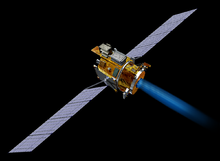Solar electric propulsion: Difference between revisions
No edit summary |
No edit summary |
||
| Line 2: | Line 2: | ||
[[File:Dawn xenon tank.jpg|thumb|The Dawn spacecraft's Xenon tank prior to integration with spacecraft. The Xenon was the propellant for the solar-power ion drive of the spacecraft which would go on to orbit two different asteroids in the early 21st century]] |
[[File:Dawn xenon tank.jpg|thumb|The Dawn spacecraft's Xenon tank prior to integration with spacecraft. The Xenon was the propellant for the solar-power ion drive of the spacecraft which would go on to orbit two different asteroids in the early 21st century]] |
||
'''Solar electric propulsion''' typically refers to the combination of [[solar cells]] and [[ion drive]] for propelling a spacecraft through [[outer space]].<ref name=NASA>{{Cite web|url=http://www.nasa.gov/mission_pages/tdm/sep/index.html|title=Solar Electric Propulsion (SEP)|last=Mohon|first=Lee|website=NASA|access-date=2016-04-24}}</ref> This technology has been studied by NASA and is considered promising.<ref name=NASA>{{Cite web|url=http://www.nasa.gov/mission_pages/tdm/sep/index.html|title=Solar Electric Propulsion (SEP)|last=Mohon|first=Lee|website=NASA|access-date=2016-04-24}}</ref> |
'''Solar electric propulsion''' typically refers to the combination of [[solar cells]] and [[ion drive]] for propelling a spacecraft through [[outer space]].<ref name=NASA>{{Cite web|url=http://www.nasa.gov/mission_pages/tdm/sep/index.html|title=Solar Electric Propulsion (SEP)|last=Mohon|first=Lee|website=NASA|access-date=2016-04-24}}</ref> This technology has been studied by NASA and is considered promising.<ref name=NASA>{{Cite web|url=http://www.nasa.gov/mission_pages/tdm/sep/index.html|title=Solar Electric Propulsion (SEP)|last=Mohon|first=Lee|website=NASA|access-date=2016-04-24}}</ref> SEP is valued for its potential for a high specific impulse, thus allowing less mass for propellant to be launched with a spacecraft and it has been evaluated for mission to Mars.<reF>[https://ntrs.nasa.gov/archive/nasa/casi.ntrs.nasa.gov/20050181421.pdf]</reF> |
||
The main concept is a nexus of [[Solar panels on spacecraft]] and [[ion thruster]]. However, there are a number of other types of [[electrically powered spacecraft propulsion]] such as the [[Arcjet]]. It may not employ an ion drive, of which there are a variety of types also. |
The main concept is a nexus of [[Solar panels on spacecraft]] and [[ion thruster]]. However, there are a number of other types of [[electrically powered spacecraft propulsion]] such as the [[Arcjet]]. It may not employ an ion drive, of which there are a variety of types also. |
||
| Line 13: | Line 13: | ||
The [[NASA Solar Technology Application Readiness]] (NSTAR) ion engine has been used with photovoltaic solar panels, which was tested on the [[Deep Space 1]] mission along with Solar Concentrator Arrays (Launched in 1998 as part of the [[New Millennium Program]]) <ref>{{cite web |url=http://www.jpl.nasa.gov/nmp/ds1/tech/index.php |title=Advanced Technologies |publisher=NASA{{\}}Jet Propulsion Laboratory |accessdate=20 November 2016}}</ref><reF>[https://solarsystem.nasa.gov/missions/deep-space-1/in-depth/]</reF> |
The [[NASA Solar Technology Application Readiness]] (NSTAR) ion engine has been used with photovoltaic solar panels, which was tested on the [[Deep Space 1]] mission along with Solar Concentrator Arrays (Launched in 1998 as part of the [[New Millennium Program]]) <ref>{{cite web |url=http://www.jpl.nasa.gov/nmp/ds1/tech/index.php |title=Advanced Technologies |publisher=NASA{{\}}Jet Propulsion Laboratory |accessdate=20 November 2016}}</ref><reF>[https://solarsystem.nasa.gov/missions/deep-space-1/in-depth/]</reF> |
||
SEP has been studied as a technolgy for a mission to Mars.<ReF>[https://ntrs.nasa.gov/archive/nasa/casi.ntrs.nasa.gov/20050181421.pdf]</reF> In particular the high [[specific impulse]] of the ion engines could lower overall mass and avoid having to use nuclear technology for power when couple with solar panels.<reF>[https://ntrs.nasa.gov/archive/nasa/casi.ntrs.nasa.gov/20050181421.pdf<r/ef> A 1998 study for SEP for a human mission suggest that a human-sized spacecraft would need 600 to 800 kilowats of electrical power coupled with ion engines with a specific impulse of 2 to 2.5 thousand.<reF>[https://ntrs.nasa.gov/archive/nasa/casi.ntrs.nasa.gov/20050181421.pdf]</ref> |
|||
==Examples== |
==Examples== |
||
Revision as of 18:14, 8 August 2018


Solar electric propulsion typically refers to the combination of solar cells and ion drive for propelling a spacecraft through outer space.[1] This technology has been studied by NASA and is considered promising.[1] SEP is valued for its potential for a high specific impulse, thus allowing less mass for propellant to be launched with a spacecraft and it has been evaluated for mission to Mars.[2]
The main concept is a nexus of Solar panels on spacecraft and ion thruster. However, there are a number of other types of electrically powered spacecraft propulsion such as the Arcjet. It may not employ an ion drive, of which there are a variety of types also.
It is also possible to generate electricity from the Sun without using photovoltaic panels, such as with solar concentrators and a Stirling engine.
A 50 kw SEP system was studied in the 2010s for a mission to an asteroid.[3] In February 2012 NASA awarded a contract for a Solar Electric Propulsion Flight System .[4]
An example of work on this type of technology is Advanced Electric Propulsion System.[5]
The NASA Solar Technology Application Readiness (NSTAR) ion engine has been used with photovoltaic solar panels, which was tested on the Deep Space 1 mission along with Solar Concentrator Arrays (Launched in 1998 as part of the New Millennium Program) [6][7]
SEP has been studied as a technolgy for a mission to Mars.[8] In particular the high specific impulse of the ion engines could lower overall mass and avoid having to use nuclear technology for power when couple with solar panels.Cite error: A <ref> tag is missing the closing </ref> (see the help page).
Examples
- Hayabusa (launched)
- Deep Space 1 (launched)
- Dawn (spacecraft) (launched)
- Asteroid Redirect Mission (cancelled)
- Deep Space Gateway (planned)
- Psyche (spacecraft) (planned)
(may not be solar)
Other types of spacecraft propulsion
See also
References
- ^ a b Mohon, Lee. "Solar Electric Propulsion (SEP)". NASA. Retrieved 2016-04-24.
- ^ [1]
- ^ "Solar Electric Propulsion: NASA's engine to Mars and Beyond - SpaceFlight Insider". www.spaceflightinsider.com. Retrieved 2018-07-28.
- ^ "NASA Awards Solar Electric Propulsion Flight System Contract".
- ^ "Advanced Electric Propulsion System successfully tested at NASA's Glenn Research Center - SpaceFlight Insider". www.spaceflightinsider.com. Retrieved 2018-07-28.
- ^ "Advanced Technologies". NASA / Jet Propulsion Laboratory. Retrieved 20 November 2016.
- ^ [2]
- ^ [3]
